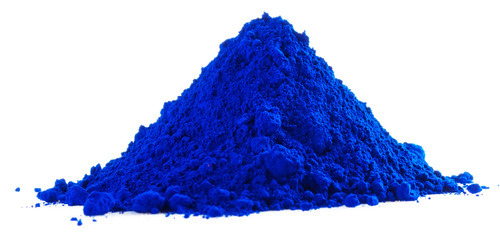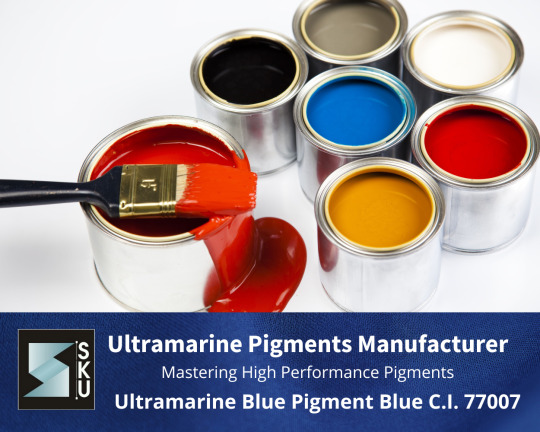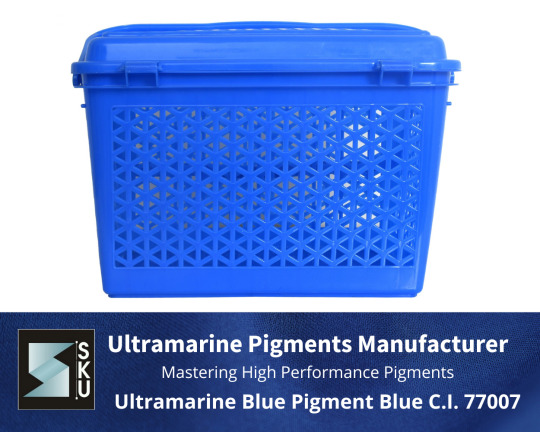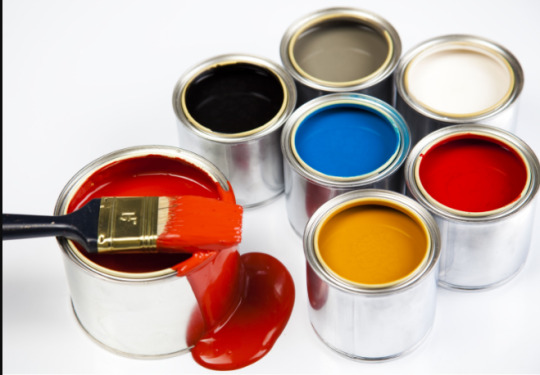Text
What Color is Ultramarine Blue?

Ultramarine blue is a vivid and deep blue color. It's often described as a rich and intense shade of blue, resembling the color of the lapis lazuli gemstone. The name "ultramarine" actually comes from the Latin words "ultra" (beyond) and "marinus" (sea), indicating that the pigment was originally derived from a rare and valuable blue mineral sourced from distant lands.
Was ultramarine blue expensive?
Yes, historically, ultramarine blue was one of the most expensive pigments used in art due to the labor-intensive process of extracting and preparing the pigment. The original source of ultramarine blue was the mineral lapis lazuli, which had to be mined primarily in Afghanistan. Extracting the vibrant blue pigment from lapis lazuli required meticulous grinding and purification, which made it a time-consuming and resource-intensive process.
Because of its rarity and the effort involved in its production, ultramarine blue was often reserved for use in the finest artworks and was considered a symbol of wealth and prestige. It was frequently used in religious paintings, particularly in depictions of the Virgin Mary's blue robe.
Over time, alternative synthetic methods for producing ultramarine blue were developed, which brought down the cost and made the pigment more accessible. Despite this, historically, ultramarine blue was indeed an expensive and prized color in the world of art.
Is ultramarine a purple blue?
No, ultramarine blue is not a purple-blue color; it is a true Ultramarine blue color with no significant purple undertones. It is a vivid and deep blue hue, often described as a rich and intense shade of blue, resembling the color of the lapis lazuli gemstone. The name "ultramarine" comes from the Latin words "ultra" (beyond) and "marinus" (sea), referring to the fact that the pigment was originally sourced from a rare blue mineral found beyond the sea.
Purple-blue colors would have more of a blend of blue and purple, leaning towards the purple side of the color spectrum. Ultramarine blue pigment is distinctively blue and does not have a strong presence of purple in its composition.
Visit at :- https://www.ultramarinebluepigments.com/
#Ultramarine Blue Colour#Ultramarine Blue Color#Blue Colour#Pigment Colour#Pigments Colour#Ultramarine Blue#Ultramarine Blue Pigment#Ultramarine Blue Pigments#SKU Pigments#SKU Pigments Limited#blue pigments#best ultramarine blue pigment#blue pigment#ultramarine blue manufacturer#ultramarine blue pigment manufacturer#ultramarine blue manufacturer in india
0 notes
Link
What is ultramarine blue pigment used for
#ultramarine blue pigment#ultramarine blue pigments#Blue Pigments#Ultramarine Pigment#Ultramarine Pigments#Blue Pigment#SKU Pigments#SKU Pigment
0 notes
Text
#ultramarine blue pigment#ultramarine blue#blue pigment#best ultramarine blue pigment#ultramarine blue manufacturer#ultramarine blue manufacturer in india#sku pigments#blue pigments#ultramarine blue pigment manufacturer#ultramarine blue pigments
0 notes
Text
https://www.ultramarinebluepigments.com/ultramarine-pigments/
Ultramarine Blue Pigment is made using raw material such as are Clay, Soda Carbonate, Sodium Sulphate, Sulphur, Pitch and Silica. Its composition is mainly defined by these raw materials, but its tonality may be defined by formulation of these raw materials in specific volumes.
#ultramarine blue pigments#ultramarine blue#blue pigments#blue pigment#ultramarine blue pigment#sku pigments#Ultramarine Pigments#best ultramarine blue pigment#ultramarine blue manufacturer#ultramarine blue pigment manufacturer#ultramarine blue manufacturer in india#Ultramarine Blue#SKU Pigments Limited
0 notes
Text
What is ultramarine blue pigment used for?
Ultramarine blue is a vivid and vibrant blue pigment that has been historically used for various artistic, decorative, and industrial purposes. It is known for its deep blue color and was traditionally made from the semi-precious gemstone lapis lazuli. In modern times, synthetic versions of ultramarine blue are more commonly used due to their cost-effectiveness and availability.
Here are some of the uses of ultramarine blue pigment:
Art and Painting: Ultramarine blue has been widely used by artists for centuries to create intense blue hues in paintings, frescoes, and other forms of visual art. It was particularly popular in Renaissance and Baroque art.
Decorative Arts: The pigment has been used in the decoration of ceramics, glass, and textiles, including tapestries, carpets, and clothing.
Printing and Printing Inks: Ultramarine blue has been used in the production of inks for printing, including traditional letterpress and modern offset printing.
Cosmetics and Personal Care Products: Ultramarine blue is used in cosmetics, such as eye shadows, eyeliners, nail polishes, and other personal care products.
Plastics and Polymers: The pigment is used in the coloring of plastics and polymers, adding a bright blue color to various plastic products.
Coatings and Paints: Ultramarine blue is used in the manufacturing of paints, coatings, and industrial finishes to provide a durable and rich blue color.
Crayons and Colored Pencils: The pigment is often used in the production of crayons, colored pencils, and other coloring materials.
Food and Beverages: In some cases, ultramarine blue may be used as a food coloring in certain food and beverage products. However, its use in food is more limited compared to other food dyes.
It's important to note that while ultramarine blue is generally considered safe for most applications, some variations of the pigment may contain trace amounts of impurities or heavy metals. As with any coloring agent, it's crucial to ensure its safety and suitability for the intended use, especially in applications involving direct contact with skin, ingestion, or inhalation.
Visit at :- https://www.ultramarinebluepigments.com/ultramarine-blue-pigments/
#ultramarine blue#ultramarine blue pigments#ultramarine blue pigment#ultramarine blue pigment manufacturer#blue pigment#sku pigments#ultramarine blue manufacturer#best ultramarine blue pigment#ultramarine blue manufacturer in india#blue pigments#Pigments
0 notes
Text

Ultramarine pigments are a group of blue pigments that have been used in art and various other applications for centuries. They are known for their intense blue color and were historically made from the semi-precious gemstone lapis lazuli, but modern versions are synthetically produced.
Visit at :- https://ultramarinebluepigments.blogspot.com/2023/07/ultramarine-pigments.html
#Ultramarine Pigments#Ultramarine Pigment#ultramarine blue pigments#Ultramarine Blue pigment#ultramarine blue#blue pigments#blue pigment
0 notes
Link
Ultramarine Pigment
#Ultramarine Pigment#Ultramarine Pigments#Ultramarine Blue Pigment#Ultramarine Blue Pigments#SKU Pigments#Blue Pigments#Blue Pigment
0 notes
Video
Ultramarine Pigments by Ultramarine Pigment
Via Flickr:
Ultramarine pigments are a group of blue pigments that have been used in art and various other applications for centuries. They are known for their intense blue color and were historically made from the semi-precious gemstone lapis lazuli, but modern versions are synthetically produced. Visit at :- ultramarinebluepigments.blogspot.com/2023/07/ultramarine-...
0 notes
Photo

Ultramarine Pigments
#Ultramarine Pigments#Ultramarine Pigment#Ultramarine blue#ultramarine blue pigment#ultramarine blue pigments#sku pigments
0 notes
Link
Ultramarine Pigments
#Ultramarine Pigments#Ultramarine Pigment#Ultramarine Blue Pigments#Ultramarine Blue Pigment#Ultramarine Blue#Blue Pigments#Blue pigment#sku pigments#Pigment
0 notes
Text
Ultramarine Pigment

Ultramarine pigments are a group of blue pigments that have been used in art and various other applications for centuries. They are known for their intense blue color and were historically made from the semi-precious gemstone lapis lazuli, but modern versions are synthetically produced.
Here are some key points about ultramarine pigments:
· Origin: The name “ultramarine” comes from the Latin phrase “ultramarinus,” which means “beyond the sea.” It refers to the fact that the pigment was originally imported from Asia, mainly from Afghanistan, where the lapis lazuli mines are located.
· Historical significance: Ultramarine has a long history of use in art, dating back to ancient times. It was highly prized and often reserved for use in the most important and sacred artworks, including religious paintings and manuscripts.
· Lapis Lazuli extraction: Lapis lazuli is a deep blue metamorphic rock containing significant amounts of the mineral lazurite, which is responsible for the blue color. To obtain ultramarine pigment from lapis lazuli, the rock was ground into a fine powder and then treated with various chemicals to extract the blue component.
· Synthetic production: Due to the high cost and limited availability of natural lapis lazuli, efforts were made to develop synthetic ultramarine pigments. In the early 19th century, a French chemist named Jean-Baptiste Guimet successfully synthesized a synthetic version of ultramarine, which became widely used and more affordable than the natural counterpart.
· Types of ultramarine pigments: There are two main types of synthetic ultramarine pigments — Ultramarine Blue (PB29) and Ultramarine Violet (PV15). Ultramarine Blue is the most commonly used and known for its deep, vibrant blue color. Ultramarine Violet has a reddish-blue hue and is used less frequently.
· Versatility: Ultramarine pigments are used in various applications beyond art, including in the cosmetic and industrial sectors. They are used to color plastics, coatings, and textiles due to their stability and resistance to fading.
· Lightfastness: Ultramarine pigments are generally considered to have good lightfastness, meaning they resist fading when exposed to light. This property is essential for the longevity of artworks and other products.
It’s worth noting that with advancements in modern pigments and colors, there are now various alternatives to ultramarine pigments with similar properties and colors. However, ultramarine pigments still hold significant historical and artistic value.
Visit at :- https://ultramarinebluepigments.blogspot.com/2023/07/ultramarine-pigments.html
#sku pigments#Ultramarine Pigment#Ultramarine Pigments#Pigments#ultramarine blue pigment#ultramarine blue pigments#blue pigments#ultramarine blue#best ultramarine blue pigment#blue pigment#ultramarine blue pigment manufacturer#ultramarine blue manufacturer#ultramarine blue manufacturer in india
0 notes
Text
https://www.ultramarinebluepigments.com/ultramarine-blue-pigments/
Ultramarine blue pigments have a captivating history that spans centuries. Derived from the precious gemstone lapis lazuli
#Ultramarine blue pigments | Contact Us Now: +91-5722-352333#ultramarine blue pigments#ultramarine pigments#blue pigments#ultramarine blue pigment
0 notes
Text
Ultramarine pigments are a group of blue pigments that have been used in art and various other applications for centuries. They are known for their intense blue color and were historically made from the semi-precious gemstone lapis lazuli, but modern versions are synthetically produced.
Visit at :- https://medium.com/@seo.ultramarinebluepigment/ultramarine-pigments-19dd588f941b
#Ultramarine pigments#Ultramarine pigment#Best Ultramarine pigments#Best Ultramarine pigment#Blue Pigment#Blue Pigments#SKU Pigments
0 notes
Photo

Choose SKU Pigment for Ultramarine Blue Pigment Manufacturing
#Ultramarine Blue Pigment#Ultramarine Blue Pigments#Blue Ultramarine blue Pigment#blue pigment#best ultramarine blue pigment#ultramaine blue colour
0 notes
Photo

Characteristics of Ultramarine Blue Pigment
#Ultramarine Blue Pigment#Ultramarine Blue Pigments#Blue Pigment#Blue Pigments#Pigment#Pigments#Ultramarine Pigment#Ultramarine Pigments#Best Ultramarine Pigment#Best Ultramarine Pigments#Best Ultramarine Blue Pigment#Best Ultramarine Blue Pigments#SKU Pigments
0 notes
Photo

Best Ultramarine Blue Colour
#Ultramarine Blue Colour#Best Ultramarine Blue Colour#Blue Colour#Pigments#Pigment#Ultramarine Blue Color#Ultramarine blue pigment#ultramarine blue pigments#sku pigment#SkU Pigments#Pigment Blue#Ultramarine Blue Pigment Manufacturer#Ultramarine Pigments#Ultramarine Pigments Manufacturer#Ultramarine Pigment
0 notes
Photo

Ultramarine Blue Pigment
#Ultramarine Blue Pigment#Ultramarine Blue Pigments#Blue Pigment#Blue Pigments#Ultramarine Blue#Pigment#SKU Pigments#SKU Pigment Private Limited
0 notes